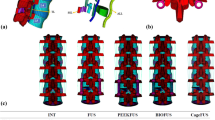Abstract
The pullout force of sublaminar and transspinous wires for segmental instrumentation which had been inserted into different segments of human cadaver spines were campared. Four different types of wiring were tested: single and double sublaminar wires, button-wires according to Drummond's technique and button-wires with the additional use of two crimps for each spinous process. A total of 50 tests were performed. In all attempts the bone proved to be the limiting factor. None of the 300 fixed wires failed. Typical types of fractures appeared with different wiring techniques. There was no statistically significant difference between the sublaminar wiring techniques tested. However, there were significant differences between sublaminar and transspinous wiring. The transspinous techniques achieved between 30% and 45% of the pull-out strength of sublaminar techniques. The forces decreased with increasing cranialisation. In all techniques the values in the upper segment (D5–D3) were almost half those of the lower segment (L5–L3). The differences of the transspinous techniques increased cranially, in favour of the technique with additional crimps. Thus, the crimps have the strongest effect on weak spinous processes. This study demonstrates that in non-dynamic testing, the stability of the bone and not the type of wiring is the limiting parameter in segmental spinal stabilisation. As the wires are inserted in different areas, the transspinous technique shows significantly lower tension forces in comparison with sublaminar wiring.
Similar content being viewed by others
References
Asher M, Carson W, Heinig C, Strippgen W, Arendt M, Lark R, Hartley M (1988) A modular spinal rod linkage system to provide rotational stability. Spine 13:272–277
Crawford RJ, Sell PJ, All MS, Dove J (1989) Segmental spinal instrumentation. A study of the mechanical properties of materials used for sublaminar fixation. Spine 14:632–635
Drummond DS (1988) Harrington instrumentation with spinous process wiring for idiopathic scoliosis. Orthop Clin North Am 19:281–289
Drummond DS, Guadagni J, Keene JS, Breed A, Narechania R (1984) Interspinous process segmental spinal instrumentation. J Pediatr Orthop 4:397–404
Drummond DS, Keene J, Breed A (1985) Segmental spinal instrumentation without sublaminar wires. Arch Orthop Trauma Surg 103:378–384
Harrington PR (1962) Treatment of scoliosis. Correction and internal fixation by spine instrumentation. J Bone Joint Surg [Am] 44:591–610
Heller KD, Forst R (1996) Surgical treatment of scoliosis in Duchenne muscular dystrophy using the ISOLA System. Third International ISOLA-Meeting, Amsterdam, January 26 1996
Herzenberg JE, Coonrad RW, Ross DB, Green NE (1988) Spinous process segmental instrumentation for scoliosis. J Spinal Disord 1:206–210
Hopf C, Forst R, Forst J, Eysel P, Reitter B (1994) Multi-segmental fusion of scoliosis in Duchenne's muscular dystrophy. Z Orthop 132:377–382
Luque ER (1977) Segmental correction of scoliosis with rigid internal fixation. Orthop Trans 1:136
Nasca RJ, Lemons JE, Walker J, Batson S (1990) Multitaxis cyclic biomechanical testing of Harrington, Luque, and Drummond implants. Spine 15:15–20
Naumann TH, Kluger P, Wilke HJ, Kron TH, Publ W (1993) Unfusionierte Wirbelsäulenaufrichtung im Wachstumsalter bei neuromuskuldren Skoliosen vom Typ Duchenne. Jahrbuch der Orthopädie. Biermann Verlag 133–141
Neuwirth MG, Drummond DS, Casden AS (1993) Results of interspinous segmental instrumentation in the sagittal plane. J Spinal Disord 6:1–4
O'Neill JA, Engler G (1988) Evaluation of spinous process wire fixation with Harrington instrumentation for idiopathic scoliosis. J Spinal Disord 1:211–218
Pampliega T, Beguiristain JL, Artieda J (1992) Neurologic complications after sublaminar wiring. Spine 17:441–445
Resina J, Ferreira-Alvez A (1977) A technique of correction and internal fixation for scoliosis. J Bone Joint Surg [Br] 60:159–165
Silverman BJ, Greenbarg PE (1988) Idiopathic scoliosis posterior spine fusion with Harrington rod and sublaminar wiring. Orthop Clin North Am 19:269–279
Songer MN, Spencer DL, Meyer PR, Jayaraman G (1991) The use of sublaminar cables to replace Luque wires. Spine 16 [Suppl] 418–421
Zhang Guang-bo, Li Zi-rong, Wie Xin-rong (1990) Interspinous process segmental instrumentation with bone-buttonwire for correction of scoliosis. Chin Med J 103:721–725
Author information
Authors and Affiliations
Rights and permissions
About this article
Cite this article
Heller, K.D., Prescher, A., Schneider, T. et al. Stability of different wiring techniques in segmental spinal instrumentation. Arch Orthop Trauma Surg 117, 96–99 (1998). https://doi.org/10.1007/BF00703452
Received:
Issue Date:
DOI: https://doi.org/10.1007/BF00703452




